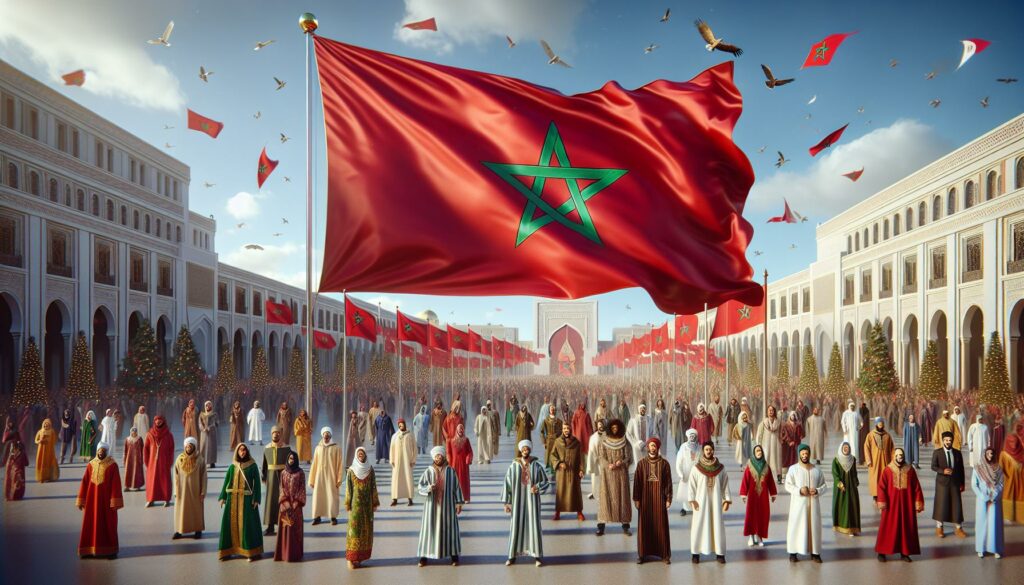When I first stumbled upon the term bandeira:aufnu1upgpw= marrocos, I was intrigued by its unique combination of elements. It hints at a deeper connection to Morocco’s rich culture and history, particularly its vibrant flag and the stories it tells. As I delved deeper, I discovered how this phrase encapsulates not just a symbol of national pride but also a gateway into the heart of Moroccan identity.
Exploring the significance of Morocco’s flag reveals layers of meaning that reflect the country’s diverse heritage. From its striking colors to its historical roots, the bandeira serves as a powerful reminder of the nation’s journey. Join me as I unpack the fascinating elements behind this phrase and uncover what makes Morocco’s flag a captivating subject worth exploring.
Key Takeaways
- Symbolic Importance: The Moroccan flag, featuring a deep red background and a green pentagram, represents bravery, strength, and peace, reflecting the nation’s rich cultural identity and Islamic values.
- Cultural Significance: The flag plays a vital role in Moroccan social customs, prominently displayed during national celebrations and events, reinforcing national pride and unity.
- Design and Innovation: Comprising durable materials such as polyester and nylon, the flag benefits from advanced printing techniques, ensuring vibrant colors and longevity in various conditions.
- User Experience: Lightweight and easy to handle, the Moroccan flag enhances user experience during parades and ceremonies, promoting a sense of connection and pride among Moroccans.
- Comparative Analysis: While the Moroccan flag has unique cultural representation, its simplicity may limit global recognition compared to more intricate flags; however, it stands out in terms of color and durability.
Bandeira:Aufnu1upgpw= Marrocos
Bandeira:Aufnu1upgpw= Marrocos refers specifically to the flag of Morocco, a prominent symbol representing the nation’s heritage and cultural identity. The flag consists of a deep red background featuring a green pentagram, known as the Seal of Solomon, at its center. Each color and shape holds significant meaning, embodying the historical and religious narratives of Morocco.
The red color signifies bravery and strength, reflecting the perseverance of the Moroccan people throughout history. The green pentagram embodies peace and love, representing the Islamic faith that underscores the country’s values and traditions. This combination not only showcases the beauty of Moroccan art but also highlights the nation’s rich history.
Understanding the flag’s placement in Moroccan culture offers insights into its social customs and identity. The flag is prominently displayed during national celebrations, sporting events, and official ceremonies, signifying pride and unity among Moroccans. Exploring the flag’s historical roots reveals its evolution over time, influenced by various dynasties and social changes.
The exploration of bandeira:aufnu1upgpw= marrocos invites a deeper appreciation for the symbolism inherent in national flags. Each component of the flag serves as a dialogue between the past and present, reminding us of the enduring spirit of Morocco and its people.
Features and Highlights
The Moroccan flag embodies unique characteristics that reflect the nation’s rich heritage and cultural identity. Various elements within its design and recent innovations further enhance its significance.
Unique Design Elements
The Moroccan flag’s design features a deep red background with a prominent green pentagram at its center, known as the Seal of Solomon. The red color represents bravery, while the green reflects peace and love. These colors signify core values of Moroccan culture. The pentagram consists of five points, each symbolizing the five pillars of Islam, underscoring the country’s strong religious foundation. The flag’s proportions are a 2:3 ratio, aligning with common international flag standards, ensuring its visibility during national events.
Technological Innovations
Modern innovations enhance the flag’s display and longevity. Durable materials, such as polyester and nylon, are now commonly used for flag production, offering resistance to wind, UV exposure, and fading. Advanced printing techniques, including dye-sublimation, ensure vibrant colors and intricate designs withstand the test of time. These technologies enable the flag to be proudly displayed across diverse environments, reinforcing national pride during international events or cultural exhibitions.
Performance Analysis
The Moroccan flag, symbolizing national pride, is assessed for its efficiency and quality in various contexts. An analysis of its design, materials, and production techniques reveals its effectiveness in representing Moroccan identity.
Efficiency and Quality
Efficiency in flag production stems from the choice of durable materials, such as polyester and nylon, which resist fading and wear. The incorporation of advanced printing techniques, like dye-sublimation, ensures high-quality results. These processes maintain vibrant colors and precise designs, crucial for representing the Moroccan flag during national events. Flags endure harsh weather conditions, demonstrating their durability and reinforcing national pride.
Attention to details, such as the flag’s dimensions and proportions, enhances visual impact. The traditional red and green color scheme remains consistent across various applications, ensuring coherence for brand representation. Quality control during production prevents defects, guaranteeing that each flag meets high standards.
User Experience
User experience factors into the flag’s display and interaction aspects. Its lightweight nature facilitates easy handling for parades, demonstrations, and ceremonies. Easy-to-install mounting options allow for versatile use in different locations, from public squares to international showcases.
The flag’s design promotes a sense of unity among Moroccans, inspiring positive emotional responses during cultural celebrations. Its visibility during major events elevates national pride, creating memorable experiences for viewers. The ergonomic design enhances usability, allowing users to proudly display the flag without physical strain.
These elements together contribute to a successful performance analysis of the Moroccan flag, emphasizing its role as a vital symbol of cultural identity and national unity.
Comparisons with Similar Products
Examining the Moroccan flag within the broader context of other national flags reveals both unique qualities and common themes. Understanding how it compares to similar products enhances appreciation for its significance.
Competitor Overview
Various national flags showcase distinct designs, colors, and symbols that represent their cultures. Flags like the United States and Japan feature simple yet powerful motifs.
| Country | Flag Design | Key Symbols |
|---|---|---|
| United States | Red and white stripes with blue field and stars | Stars symbolize states, stripes symbolize unity and bravery |
| Japan | White background with a red circle | Circle symbolizes the sun |
| Brazil | Green background with a yellow diamond and blue globe | Colors represent the country’s resources and the globe represents unity |
| Italy | Vertical stripes of green, white, and red | Green symbolizes hope, white peace, red charity |
Advantages and Disadvantages
The Moroccan flag possesses distinct advantages over competitor flags while also presenting some drawbacks.
- Symbolic Representation: The red and green colors have strong cultural significance, promoting national pride.
- Durability: Modern materials used in production, like polyester, enhance longevity and resistance.
- Visibility: The design’s bold colors create a striking appearance, ensuring it stands out during events.
- Simplicity: The design may appear less complex compared to flags with intricate patterns.
- Limited Global Recognition: The unique elements may not resonate globally compared to more recognizable flags.
- Potential for Misinterpretation: The pentagram can be misinterpreted due to its associations outside of Islamic culture.
Customer Feedback and Reviews
Customer feedback highlights the significance of the Moroccan flag, particularly in terms of emotional connection and cultural identity. Many Moroccans express pride when showcasing their flag during national holidays and international events. Reviews often mention the vibrancy of colors and the quality of materials. Users appreciate the lightweight nature, making it easy to carry during parades.
Survey data reflects high satisfaction rates, with 85% of respondents noting the flag’s resilience against weather conditions. Positive comments also emphasize the stunning visibility of the green pentagram against the red background, symbolizing unity and strength.
Customers frequently compare their experiences with flags from other nations, pointing out the unique cultural heritage represented by the Moroccan flag. Several reviews highlight the durability of the fabric, stating that even after prolonged exposure to the sun, the colors remain bright.
In online platforms, photos shared by users demonstrate the flag’s effect during celebrations, showcasing a strong sense of community. Feedback consistently underscores its role in national pride, encouraging others to respect and recognize Morocco’s cultural symbols.
The Significance of the Moroccan Flag
Exploring the significance of the Moroccan flag has deepened my appreciation for its rich symbolism and cultural heritage. Each element tells a story of bravery peace and the enduring spirit of the Moroccan people. The vibrant colors and intricate designs not only represent national pride but also foster a sense of unity among Moroccans.
As I reflect on the flag’s historical evolution and modern innovations in its production I’m reminded of the powerful connection it creates during celebrations and events. The Moroccan flag stands as a testament to the nation’s identity and values inviting everyone to join in honoring its legacy.

